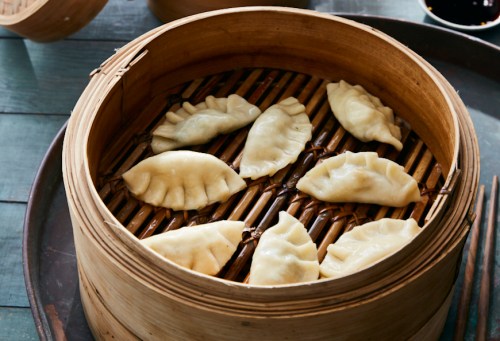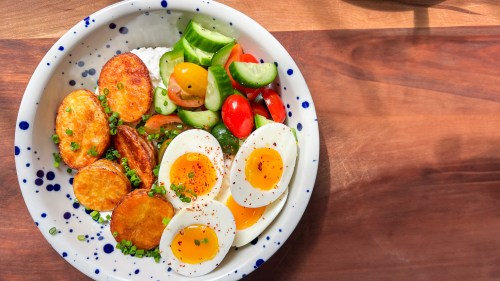Our editors independently select these products. Making a purchase through our links may earn Well+Good a commission
This Cookbook Celebrates the Food and Culture of Refugees in America
The Refugees for Refuge cookbook shares recipes and stories of refugees living in America. Learn more about the book and get one of the recipes.

It’s an understatement to say that refugees are some of the most resilient people on Earth. They are forced to leave their homes due to persecution, war, or violence, and may struggle to find their footing in neighboring countries that are hostile to their very presence (the United States included). Many have lost or had to leave behind families and most of their possessions. But as Betina Simmons learned when volunteering with Refugee Women’s Alliance in Seattle, Washington, many refugees use cooking as a way to still feel connected when far from home.
“I’d been volunteering with ReWA for about a year when I was asked to host a cooking party for two supporters who had offered to teach a class on how to make authentic Bariis, or Somali rice,” she says. The meal served as a conversation starter to talk more about refugees and the work that ReWA does, and led to the idea of putting together a whole cookbook of recipes from refugees.
In the months that followed, Simmons and a team consisting of a portrait photographer, food photographer, food and prop stylists, and a set designer (all volunteers and primarily female), hosted potluck English Second Language classes as a way to compile recipes and stories from local refugees from more than 30 countries, including China, Somalia, Ethiopia, Iraq, Iran, Afghanistan, Thailand, Mexico, Russia, Ukraine, Poland, and Columbia.
“It was profoundly moving to have the opportunity to listen to these powerful journey stories,” Simmons says. “Along with the harrowing experiences, loss, and heartbreak, I witnessed unbelievable strength and resilience. It was a true honor to be entrusted with recording the events shared with us. The portrait shoots were remarkable— most people were genuinely excited to have their photo taken by a professional photographer, and many dressed up for the occasion.”
The end result of the collection of recipes, photos, and stories is the Recipes for Refuge ($35) cookbook, which includes not only the recipes from counties across the globe, but also the stories of how the women featured journeyed to the U.S. and what they left behind. Simmons says she hopes that the cookbook will help bridge an understanding between the refugee population in the U.S. and people who may not think or know much about them.
“All of the people that I met had incredible and often traumatic life stories, and yet they are finding their way here.” — Betina Simmons, ReWA
“Through the stories, portraits, and recipes in this book, the reader can really see the individuals and perhaps get to know them a little,” Simmons says. “Our hope is that this project fosters understanding and empathy for those impelled by untenable situations beyond their control to leave all that they knew and loved behind for a chance at survival, safety, and freedom. All of the people that I met had incredible and often traumatic life stories, and yet they are finding their way here, learning a new language, securing work—often completely starting over because their credentials don’t apply, many managing to send money to loved ones left behind.”
And of course just as much as learning the stories, you learn delicious recipes, too. Excerpted here is one of Simmons’ favorites: jiaozi, or dumplings. The recipe is from a refugee from Northern China named Annie Liu, who grew up in the small farming community of Heilongjiang Province.
Growing up, Liu’s family didn’t have much money, but they made jiaozi on special occasions like the Lunar New Year. Now, Liu works as an accounts payable specialist for ReWA—her job for over 20 years—and has the means to make jiaozi more than just once a year, although they are still very special to her. And knowing this recipe’s origins, it surely will be to you, too.
Jiaozi (excerpted from the Recipes for Refuge cookbook)
Ingredients
For the dough:
*Note: You can also use wonton wrappers in place of dough, to save time.3/4 – 1 cup cold water2 cups all-purpose flour, plus extra for dusting
For the filling:
1 Tbsp vegetable oil3 small fried tofu cakes, chopped to the size of grains of rice2 cups fresh shiitake mushrooms, chopped to the size of grains of rice1/2 tsp ginger, minced1 pinch ground Szechuan pepper powder1 pinch ground anise powder3 Tbsp soy sauce1 tsp salt, plus more as needed1/2 napa cabbage, thinly sliced1 small bunch of fresh dill, chopped
For the dipping sauce:
1/2 cup soy sauce1 tsp seasoned rice wine vinegar1/2 tsp sesame oilOptional additions: red pepper flakes, minced garlic, fermented tofu, chive flowers, or any spice you like
To make the dough:
1. Add up to three-fourths cup of very cold water into the flour while continuously stirring. Knead the dough, adding more water if needed, to make it nice and pliable.
2. Cover with a clean dish towel and set aside. (Annie says her mother used to cover the dough with a dish towel, but she was very particular about it being freshly washed, and, thus, extra clean.)
To make the filling:
1. Heat the oil on medium in a wok. Add the tofu and mushrooms, and mix for one minute. Add the ginger, Szechuan pepper powder, anise powder, soy sauce, and salt. Mix until cooked through. Set aside.
2. Sprinkle a little salt over the cabbage slices. Wait two minutes, then layer the slices between two sheets of paper towels and gently press out any excess water.
3. Add the cabbage and dill into the cooked mixture. Add more salt as needed.
To assemble:
1. Dust a cutting board with flour. Roll the dough into a rope, about an inch-and-a-half in diameter. Cute the rope of dough into small half-inch coin-shaped pieces. Use a rolling pin to shape the small pieces of dough into thin circles, about three-and-a-half inches in diameter.
2. Dust the rolling pin and circles of dough with more flour to prevent sticking.
3. Place one tablespoon of filling int the center of each thin circle of dough. Fold each into a semicircle, press the edges together, and give the dumplings a little twist to seal the dough tightly and prevent the filling from leaking.
4. If boiling, bring a pot of water to a boil. Add several dumplings at once. Stir gently to prevent them from sticking to one another. Once the dumplings fill with air and puff up like balloons, use a slotted spoon to take them out and place them in a colander to drain. Once drained, transfer the dumplings to a dish lined with aluminum foil.
5. If steaming, place the dumplings on a well-oiled surface in a steamer basket over boiling water. Steam for approximately six minutes, or until done.
Did you like this recipe from the Recipes for Refuge cookbook? Get more healthy recipe ideas in Well+Good’s Cook With Us Facebook group—and share your own faves there, too!
Sign Up for Our Daily Newsletter
Get all the latest in wellness, trends, food, fitness, beauty, and more delivered right to your inbox.
Got it, you've been added to our email list.










